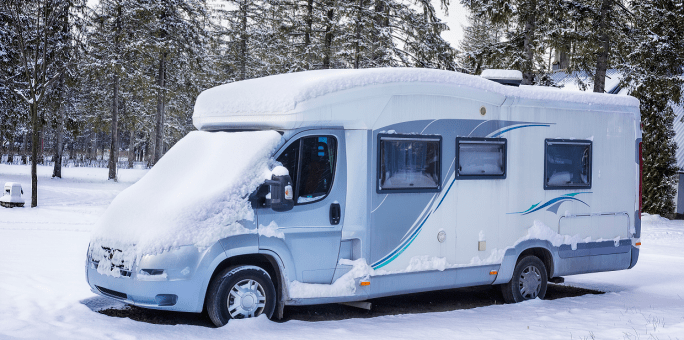
9 Best Tips For Winter Storage
Full Disclosure: I live in my RV year round. However, many Americans use their RV’s for vacation trips. Some for a week-end or two or three, some for a week or two, and others, well others are retired and come and go for as long as they want, but keep their home as “base”.
Winter is coming. Typically, when the foliage of fall begins to turn brown and fall to the ground, it often means it’s time to put your recreational vehicle (RV) away until the warmer weather returns in the spring. Taking the time to prepare your RV before you store it for the winter may help the long-term protection of your investment, says Art Dack, parts programs manager with RV Care, an RV dealer network.
Water freezes at 32 degrees Fahrenheit, so, when you’re finished using your RV for the season, and when the temperature is expected to stay below freezing for 24 hours or more, Dack suggests performing these pre storage tasks to help ensure your RV is road-ready when spring arrives.
1. Drain the Water System
This might be the most critical step for winterizing your RV, Dack says. Any water left in the plumbing system can freeze and break fittings and lines — damage that may be costly to repair, Dack says.
Depending on the complexity of your RV’s plumbing system, winterizing it may be a do-it-yourself process, he adds. It’s a matter of draining the fresh water and waste tanks, draining all water out of the pipes and pumping nontoxic RV antifreeze through the entire water system. Nontoxic RV antifreeze pushes water out of your plumbing system, according to Family Motor Coaching magazine. Your owner’s manual should also include a checklist for draining the water system.
However, if you don’t feel qualified to do it yourself — or don’t want to invest the time — a trained professional at a reputable service center can provide this service for a fee.
2. Prep the Exterior
A service center can also do a thorough inspection of the roof, sidewalls, seams, windows, exterior doors and access panels — and reseal or re-caulk any holes or cracks. That will help prevent water getting in where it shouldn’t — and help protect you from potentially costly repairs come spring.
Before resealing any holes or cracks, consult with your RV dealer. It’s important to select the right sealant for your RV and your climate, Dack says. The wrong sealant might not set properly, leaving your RV susceptible to water damage. You may feel more comfortable having a trained professional reseal your RV — possibly in conjunction with draining the water system.
3. Choose a Safe Location

RV garages are the best option. Photo courtesy of SteelMaster on Flickr Creative Commons
Ideally, you’ll be able to park your RV for the winter in a shelter or under a roof, according to Dack. “But for some RV owners, that’s just not possible,” he says. If you’re planning to store your RV in your driveway or yard, try to find a location that’s sheltered from the wind, and park the RV out of the way of any trees that may come down in a wind or ice storm.
If you’re hoping to park your RV on the street for the winter, be sure to check your city code first. Parking regulations for motorhomes may vary from city to city, according to the Family Motor Coach Association, but many restrict street parking.
4. Cover Up Your RV
If your RV will be outside all winter, Dack recommends investing in a cover made especially for an RV. The cover will protect against extended exposure to ultraviolet (UV) rays that can damage the paint finish. It will also protect your vehicle from wind damage, tree sap and bird droppings.
“Don’t use a plastic tarp because plastic will trap moisture between the RV and the tarp,” he says. A tarp is also likely to flap around in the wind and may damage exterior surfaces. Instead, Dack suggests getting a cover specifically designed for your RV and your climate. Universal or custom-designed covers have a system of straps to keep your RV wrapped up tight, according to Family Motor Coaching magazine. Plus, they have zippered openings to allow you into the RV, if necessary.
“Follow the manufacturer’s instructions for putting the cover on,” Dack says. “You want to be sure it’s cinched tight so that it keeps moisture and wind out.”
5. Protect the Tires
Tires may be susceptible to damage due to UV rays from the sun. Protect your tires with covers that are often available at your RV dealership. Dack notes that not all covers designed for the body of the RV also cover the tires. Tire covers that fit properly will likely protect the tires all winter.
In addition, Family Motor Coaching magazine recommends inflating all of the tires to the pressure indicated on the sidewalls before storage. Tires may lose pressure during storage; so be sure to check the tires and inflate them again before taking your RV out on the road again.
6. Save Your Batteries
Disconnect the batteries and store them in a cool — but not cold — and dry place, recommends KOA.com. Batteries will lose some of their charge in storage; the cool temperature slows that loss. Check the charge every four to six weeks with a voltmeter or multimeter, and charge the batteries as necessary to keep them fully charged, Dack recommends. This is important because a partially charged battery may freeze faster than a fully charged one, KOA.com notes. Freezing can damage or destroy the batteries.
7. Add Fuel Stabilizer
Gas can go bad over time, according to The Wall Street Journal, resulting in sticky resin deposits. Those gummy deposits are caused by oxidation — and they can damage an engine, Dack warns. So be sure to use a fuel stabilizer, which prevents the deposits from forming, according to RoadandTrack.com.
First add the stabilizer according to the product’s package instructions and then fill the rest of the tank with gas, KOA.com recommends. Start both the engine and generator, and let them run for a few minutes, following the directions on the bottle (usually 5 to 10 minutes) to allow the stabilizer to work its way through the entire fuel system. In addition, KOA.com suggests changing the oil and oil filter in the engine and in the generator before storage, because acids in used oil can cause corrosion.
8. Make It Critter-Resistant
Mice and squirrels enjoy making their winter home in an RV, where they may chew through wiring, plastic and rubber components, according to the Family Motor Coach Association. To discourage the rodents, remove temptation: Be sure to remove all food from the RV, then thoroughly clean the refrigerator, freezer, cupboards, countertops and floors, Dack recommends.
Consider placing mouse and ant traps in and around your RV, KOA suggests. And, pay special attention to where rodents can get in. Your RV dealer or service provider can inspect the underside of your RV and seal any holes or cracks. “Rodents love to run up the RV’s auxiliary electrical power cable and climb in where the cord goes through the wall,” he explains. “So unplug the cord, disconnect from the RV and make sure the cable hatch is closed tight.”
9. Check Up on Your Stored RV
If possible, do a quick inspection of your stored RV every few weeks while it’s in storage, Dack recommends. “Check for any exterior damage, water penetration or odors inside,” he adds. “If you find any problems, get your RV to a service center for repairs right away — the damage may only get worse by spring.”
Follow these nine tips to help ensure your RV is ready to hit the road again in the spring.
ARTICLES FOR YOU:
- Got Ants? Here is The Best Way to Get Rid of Ants In Your RV
- Cleaning Tips for Your RV
- Top 10 All Weather RV’s
Looking for a place to stay in SW Missouri? Come on by. Blue Skys RV Park has both short term and long term parking. We are a no frills, affordable, family friendly place to stay. Free Wifi and a laundromat. Whether you are looking for overnight, weekly, or long term, Blue Skys RV Park is the place to be. The owners will go above and beyond to make your stay a pleasant one. Check us out: https://blueskysrvpark.com

